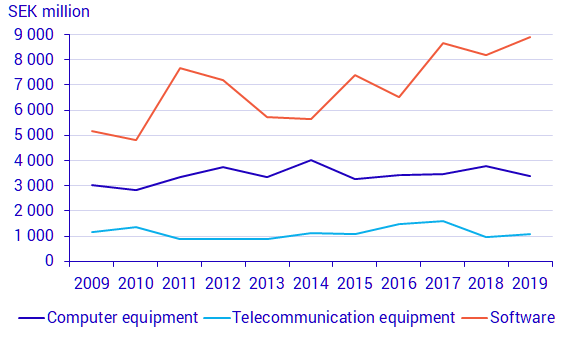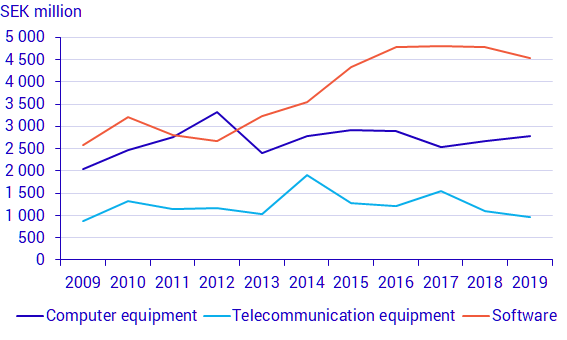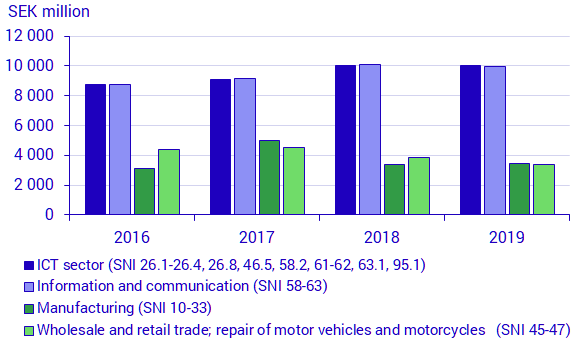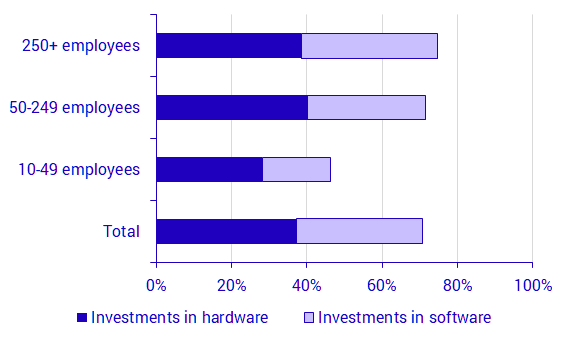Enterprises' IT expenditure, 2019
Software – the largest IT-related expenditure for enterprises
Statistical news from Statistics Sweden 2020-09-30 9.30
Enterprises’ expenditures and investments in hardware and software amounted to SEK 72.4 billion in 2019. Among the largest enterprises (250 employees or more), hardware and software accounted for 70 percent of expenses and investments in 2019.
In addition to expenditures and investments in software, enterprises can also have own personnel, such as systems scientists or programmers working on software development.
| Sector | Percentage of all examined industries |
|---|---|
| Goods-producing sector (05-43) | 8% |
| Service-producing sector (45-47, 49-53, 55-56, 58-63, 64-66, 68, 69-82, 90-93, 95.1) | 14% |
| ICT-sector (SNI 26.1-26.4, 26.8, 46.5, 58.2, 61-62, 63.1, 95.1) | 60% |
| Total (all examined industries) | 11% |
In 2019, 11 percent of enterprises had personnel working on software development. The ICT sector noted the largest percentage of enterprises with software development, at 60 percent.
More than half of expenditures and investments in IT consist of software
| Industries (SNI) | Computer equipment | Telecommunication equipment | Software |
|---|---|---|---|
| Mining and quarrying (SNI 05-09) | .. | .. | .. |
| Manufacturing (SNI 10-33) | 2 205 | 1 246 | 9 869 |
| Construction (SNI 41-43) | 762 | 496 | 1 112 |
| Wholesale and retail trade; repair of motor vehicles and motorcycles (SNI 45-47) | 2 594 | 783 | 8 047 |
| Transportation and storage (SNI 49-53) | 541 | 325 | 2 357 |
| Accommodation and food service activities (SNI 55-56) | 304 | 78 | 348 |
| Information and communication (SNI 58-63) | 3 225 | 6 716 | 8 075 |
| Financial and insurance activities (SNI 64-66) | 1 021 | 283 | 10 700 |
| Real estate activities (SNI 68) | 238 | 125 | 852 |
| Arts, entertainment and recreation (SNI 90-93) | 264 | 36 | 508 |
| ICT-sector (SNI 26.1-26.4, 26.8, 46.5, 58.2, 61-62, 63.1, 95.1) | 3 276 | 6 751 | 7 880 |
| Total (all examined industries) | 13 305 | 10 840 | 48 220 |
Software is the largest IT-related expense or investment for enterprises. Over the last eleven years, software has increased by 76 percent among small enterprises (10-49 employees) and by 72 percent among mid-sized enterprises (50-249 employees).
Since 2009, expenses and investments in hardware have increased by 28 percent among small enterprises and by 7 percent among mid-sized enterprises.

Mid-sized enterprises accounted for 18 percent, which corresponds to SEK 13.4 billion, of total expenses and investments in hardware and software in 2019.

Small enterprises accounted for 11 percent, which corresponds to SEK 8.3 billion, of total expenses and investments in hardware and software in 2019.
Three largest industries in hardware
Information and communication, manufacturing, and wholesale and retail trade industries are consistently the largest market players in hardware. Together, these three industries accounted for 69 percent, corresponding to SEK 16.8 million, of total expenses and investments in 2019. The combined expenses and investments in hardware decreased by just over SEK 328 million compared to 2018.

Small enterprises invested less in hardware and software
Total investments in hardware and software amounted to SEK 25.1 billion in 2019, which corresponds to 35 percent of total expenses and investments. Among large and mid-sized enterprises, investments in hardware accounted for 39 percent and 40 percent respectively and investments in software accounted for 36 percent and 31 percent respectively. Small enterprises capitalised costs to a lesser extent, which mean these items were expensed and included in the income statement, rather than entered as tangible and intangible assets. In 2019, investments in hardware accounted for 28 percent and investments in software accounted for 18 percent. Capitalising costs for computer equipment was most common and amounted to SEK 5.5 billion in 2019.

Operational leasing – the most common form of leasing
Operational leasing was the most common form of hardware leasing in 2019. Among total hardware leasing expenses, operational leasing accounted for 92 percent.

The industries with the largest expenses and investments in hardware - information and communication, manufacturing and wholesale and retail trade - also have the largest expenses of operational leasing on hardware. Their combined expenses for operational leasing amounted to SEK 4.1 billion in 2019.
Expenses for internal IT services have increased

Enterprises purchased IT services for SEK 73.9 billion in 2019. This year’s survey shows a similar trend to previous years, in which internal IT services increased more than external IT services, by 6 percent in 2018 and by 15 percent in 2019.
Definitions and explanations
All figures are presented in 2019 fixed prices. The GDP deflator is used for the calculation of fixed prices, and is calculated as the quotient of nominal GDP and fixed-price adjusted GDP.
Expenses and investments in hardware and software
Expenses for hardware and software refers to expensed computer and telecommunication equipment, and software. Expenses for hardware also include financial and operational leasing of computer and telecommunication equipment. Expenses for software include internal and external IT services.
Investments in hardware and software refers to capitalised costs for hardware and software and are included as tangible and intangible assets.
Financial and operational leasing
Financial leasing involves a monthly cost for the consumer and the consumer is responsible for the product during the lease period. Financial leasing resembles a purchase in which the purchase expires once all the installments have been made.
Operational leasing involves a monthly cost for the consumer. However, the consumer is not responsible for services, maintenance or insurance during the lease period. Operational leasing resembles a normal rental agreement.
IT services
An IT service refers to IT functions that an enterprise purchases without needing to invest in IT equipment. These functions can include items such as service, maintenance, and cloud services. IT services can be procured internally from other enterprises within the franchise, or from external suppliers.
Publication
In this year’s survey, two questions were added concerning artificial intelligence, in view of a government task to Statistics Sweden from the Ministry of Infrastructure, Ref. no. I2019/01964/D. These statistics will not be published on the product web page on Enterprises’ IT expenditure. They will, instead, be included in a separate report to be published on 25 November 2020 on the product web page on research and development in Sweden, at scb.se/UF0301.
Statistical Database
More information is available in the Statistical Database
Feel free to use the facts from this statistical news but remember to state Source: Statistics Sweden.
